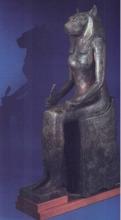Bast
(Ubasti; G/R Bastet, Bubastis) - "Devouring Lady" (from bas, to devour, with feminine ending); One of the earliest-documented Names with an appearance in Dynasty II, Bast is first and foremost a protectress; specifically of the royal house and the Two Lands. During Dynasty IV, She was a patron-Name of Lower Kemet, paired with Hethert as a patron-Name of Upper Kemet, as Wadjet and Nekhbet are often depicted in later times; the Valley Temple of the Pyramid of Khafra at modern-day Giza next to the Sphinx had a "Portal of Bast" as well as statues of Bast in the company of the king. Over time, Bast's image metamorphosed to become more similar to that of Hethert; eventually, into the Greek period, She would be equated with the virgin huntress Artemis and considered the protectress of children and pregnant mothers, musicians and a goddess of all sorts of excess, especially sexual excess. However, Bast's original visage did not include the "cat as sex symbol" archetype. (Incidentally, it is also from the Greeks that the erroneous belief in Bast as a daughter of Aset and Wesir derives; Bast as Artemis had to have a twin brother, Apollo (equated with Heru-sa-Aset by the Greeks).) A play on words in Bast's name resulted in Her being equated in Greco-Roman times with the "soul of Isis" (ba-Aset), probably in keeping with Aset's gradual syncretism into the Roman Isis of Ten Thousand Names.


